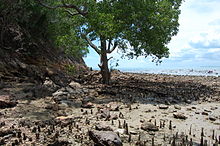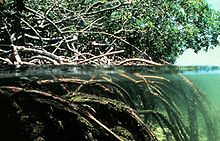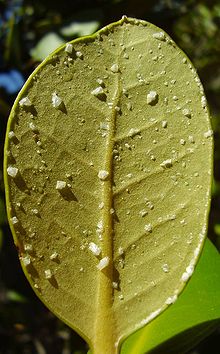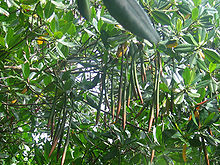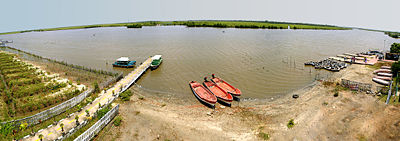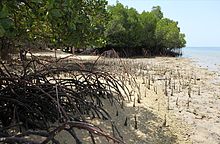- Mangrove
-
Short video of a mangrove in Brazil

- For the Caribbean restaurant in London, see Mangrove restaurant
Mangroves are various kinds of trees up to medium height and shrubs that grow in saline coastal sediment habitats in the tropics and subtropics – mainly between latitudes 25° N and 25° S. The word is used in at least three senses: (1) most broadly to refer to the habitat and entire plant assemblage or mangal,[1] for which the terms mangrove forest biome, mangrove swamp and mangrove forest are also used, (2) to refer to all trees and large shrubs in the mangal, and (3) narrowly to refer to the mangrove family of plants, the Rhizophoraceae, or even more specifically just to mangrove trees of the genus Rhizophora.
The mangrove biome, or mangel, is a distinct saline woodland or shrubland habitat characterized by a depositional coastal environments, where fine sediments (often with high organic content) collect in areas protected from high-energy wave action. Mangroves dominate three quarters of tropical coastlines.[2] The saline conditions tolerated by various mangrove species range from brackish water, through pure seawater (30 to 40 ppt), to water concentrated by evaporation to over twice the salinity of ocean seawater (up to 90 ppt).[3][2]
Contents
Ecology
Mangroves are found in tropical and subtropical tidal areas. Areas where mangals occur include estuaries and marine shorelines.[3]
The intertidal existence to which these trees are adapted repesents the major limitation to the number of species able to thrive in their habitat. High tide brings in salt water, and when the tide recedes, solar evaporation of the seawater in the soil leads to further increases in salinity. The return of tide can flush out these soils, bringing them back to salinity levels comparable to that of seawater. At low tide, organisms are also exposed to increases in temperature and desiccation, and are then cooled and flooded by the tide. Thus, in order for a plant to survive in this environment, it must tolerate broad ranges of salinity, temperature, and moisture, as well as a number of other key environmental factors. It is unsurprising, perhaps, that only a select few species make up the mangrove tree community.
About 110 species are considered mangroves.[3] However, a given mangrove typically features only a small number of tree species. It is not uncommon for a mangrove forest in the Caribbean to feature only three or four tree species. For comparison, the tropical rainforest biome contains thousands of tree species. That is not to say that mangrove forests lack diversity. Though the trees themselves are few in species, the ecosystem that these trees create provides a home for a great variety of other organisms.
Mangroves require a number of physiological adaptations to overcome the problems of anoxia, high salinity and frequent tidal inundation. Each species has its own solutions to these problems; this may be the primary reason why, on some shorelines, mangrove tree species show distinct zonation. Small environmental variations within a mangal may lead to greatly differing methods for coping with the environment. Therefore, the mix of species is partly determined by the tolerances of individual species to physical conditions, like tidal inundation and salinity, but may also be influenced by other factors such as predation of plant seedlings by crabs.
Once established, mangrove roots provide an oyster habitat and slow water flow, thereby enhancing sediment deposition in areas where it is already occurring. The fine, anoxic sediments under mangroves act as sinks for a variety of heavy (trace) metals which colloidal particles in the sediments scavenged from the water. Mangrove removal disturbs these underlying sediments, often creating problems of trace metal contamination of seawater and biota.
Mangroves protect coastal areas from erosion, storm surge (especially during hurricanes), and tsunamis.[4][5] The mangroves' massive root systems are efficient at dissipating wave energy.[6] Likewise, they slow down tidal water enough that its sediment is deposited as the tide comes in, leaving all except fine particles when the tide ebbs.[7] In this way, mangroves build their own environment.[4] Because of the uniqueness of mangrove ecosystems and the protection against erosion they provide, they are often the object of conservation programs, including national biodiversity action plans.[5]
However, mangroves' protective value is sometimes overstated. Wave energy is typically low in areas where mangroves grow,[8] so their effect on erosion can only be measured over long periods.[6] Their capacity to limit high-energy wave erosion is limited to events such as storm surges and tsunamis.[9] Erosion often occurs on the outer sides of bends in river channels that wind through mangroves, while new stands of mangroves are appearing on the inner sides where sediment is accruing.[citation needed]
The unique ecosystem found in the intricate mesh of mangrove roots offers a quiet marine region for young organisms. In areas where roots are permanently submerged, the organisms they host include algae, barnacles, oysters, sponges, and bryozoans, which all require a hard surface for anchoring while they filter feed. Shrimps and mud lobsters use the muddy bottoms as their home.[10] Mangrove crabs mulch the mangrove leaves, adding nutritients to the mangal muds for other bottom feeders.[11] In at least some cases, export of carbon fixed in mangroves is important in coastal food webs.
Mangrove plantations in Vietnam, Thailand, the Philippines and India host several commercially important species of fish and crustaceans. Despite restoration efforts, developers and others have removed over half of the world's mangroves in recent times.
Biology
Of the recognized 110 mangrove species, only about 54 species in 20 genera from 16 families constitute the "true mangroves", species that occur almost exclusively in mangrove habitats.[1] Demonstrating convergent evolution, many of these species found similar solutions to the tropical conditions of variable salinity, tidal range (inundation), anaerobic soils and intense sunlight. Plant biodiversity is generally low in a given mangal.[3] This is especially true in higher latitudes and in the Americas. The greatest biodiversity occurs in the mangal of New Guinea, Indonesia and Malaysia.[12]
Adaptations to low oxygen
Red mangroves, which can survive in the most inundated areas, prop themselves above the water level with stilt roots and can then absorb air through pores in their bark (lenticels). Black mangroves live on higher ground and make many pneumatophores (specialised root-like structures which stick up out of the soil like straws for breathing) which are also covered in lenticels. These "breathing tubes" typically reach heights of up to thirty centimeters, and in some species, over three meters. There are four types of pneumatophore—stilt or prop type, snorkel or peg type, knee type, and ribbon or plank type. Knee and ribbon types may be combined with buttress roots at the base of the tree. The roots also contain wide aerenchyma to facilitate transport within the plant.
Limiting salt intake
Red mangroves exclude salt by having significantly impermeable roots which are highly suberised, acting as an ultrafiltration mechanism to exclude sodium salts from the rest of the plant. Analysis of water inside mangroves has shown 90% to 97% of salt has been excluded at the roots. Salt which does accumulate in the shoot, concentrates in old leaves which the plant then sheds. Red mangroves can also store salt in cell vacuoles. As seen in the picture on the right, white (or grey) mangroves can secrete salts directly; they have two salt glands at each leaf base (co-relating with their name—they are covered in white salt crystals).
Limiting water loss
Because of the limited fresh water available in salty intertidal soils, mangroves limit the amount of water they lose through their leaves. They can restrict the opening of their stomata (pores on the leaf surfaces, which exchange carbon dioxide gas and water vapour during photosynthesis). They also vary the orientation of their leaves to avoid the harsh midday sun and so reduce evaporation from the leaves. Anthony Calfo, a noted aquarium author, observed anecdotally a red mangrove in captivity only grows if its leaves are misted with fresh water several times a week, simulating the frequent tropical rainstorms.[13]
Nutrient uptake
The biggest problem that mangroves face is nutrient uptake. Because the soil is perpetually waterlogged, there is little free oxygen. Anaerobic bacteria liberate nitrogen gas, soluble iron, inorganic phosphates, sulfides, and methane, which makes the soil much less nutritious and contributes to mangroves' pungent odor.[citation needed] Pnuematophores (aerial roots) allow mangroves to absorb gases directly from the atmosphere, and other nutrients such as iron, from the inhospitable soil. Mangroves store gases directly inside the roots, processing them even when the roots are submerged during high tide.
Increasing survival of offspring
In this harsh environment, mangroves have evolved a special mechanism to help their offspring survive. Mangrove seeds are buoyant and therefore suited to water dispersal. Unlike most plants, whose seeds germinate in soil, many mangroves (e.g. red mangrove) are viviparous, whose seeds germinate while still attached to the parent tree. Once germinated, the seedling grows either within the fruit (e.g. Aegialitis, Avicennia and Aegiceras), or out through the fruit (e.g. Rhizophora, Ceriops, Bruguiera and Nypa) to form a propagule (a ready-to-go seedling) which can produce its own food via photosynthesis. The mature propagule then drops into the water, which can transport it great distances. Propagules can survive desiccation and remain dormant for over a year before arriving in a suitable environment. Once a propagule is ready to root, its density changes so the elongated shape now floats vertically rather than horizontally. In this position, it is more likely to lodge in the mud and root. If it does not root, it can alter its density and drift again in search of more favorable conditions.
Taxonomy and Evolution
The following listing (modified from Tomlinson, 1986) gives the number of species of mangroves in each listed plant genus and family. Mangrove environments in the Eastern Hemisphere harbor six times as many species of trees and shrubs as do mangroves in the New World. Genetic divergence of mangrove lineages from terrestrial relatives, in combination with fossil evidence, suggests that mangrove diversity is limited by evolutionary transition into the stressful marine environment and that the number of mangrove lineages has increased steadily over the Tertiary with little global extinction. [14]
Major components
Family Genus, number of species Common name Acanthaceae, Avicenniaceae or Verbenaceae
(family allocation disputed)Avicennia, 9 Black mangrove Combretaceae Conocarpus, 1; Laguncularia, 11; Lumnitzera, 2 Buttonwood, white mangrove Arecaceae Nypa, 1 Mangrove palm Rhizophoraceae Bruguiera, 6; Ceriops, 2; Kandelia, 1; Rhizophora, 8 Red mangrove Lythraceae Sonneratia, 5 Mangrove apple Minor components
Family Genus, number of species Acanthaceae Acanthus, 1; Bravaisia, 2 Bombacaceae Camptostemon, 2 Cyperaceae Fimbristylis, 1 Euphorbiaceae Excoecaria, 2 Lecythidaceae Barringtonia, 6 Lythraceae Pemphis, 1 Meliaceae Xylocarpus, 2 Myrsinaceae Aegiceras, 2 Myrtaceae Osbornia, 1 Pellicieraceae Pelliciera, 1 Plumbaginaceae Aegialitis, 2 Pteridaceae Acrostichum, 3 Rubiaceae Scyphiphora, 1 Sterculiaceae Heritiera, 3 Geographical regions
Mangroves occur in numerous areas worldwide. See List of mangrove ecoregions.
Africa
There are important mangrove swamps in Kenya, Tanzania and Madagascar, with the latter even admixing at the coastal verge with dry deciduous forests.
Nigeria has Africa's largest mangrove concentration, spanning 36,000 km2. Oil spills and leaks have destroyed many in the last fifty years, damaging the local fishing economy and water quality.[15]
Along the of the Red Sea, both on the Egyptian side and in the Gulf of Aqaba, mangroves composed primarily of Avicennia marina and Rhyzophora mucronata in about 28 stands cover about 525 hectares.[citation needed] Almost all Egyption mangrove stands are now protected.[citation needed].
Americas
Mangroves live in many parts of the tropical and subtropical coastal zones of North, South and Central America.
Continental United States
Because of their sensitivity to subfreezing temperatures, mangroves in the continental United States are limited to the Florida peninsula (see Florida mangroves) and isolated growths[16] of black mangrove (Avicennia germinans) along the coast of southern Louisiana[17] and south Texas[18]
Central America and Caribbean
Mangroves occur on the west coast of Costa Rica, on the Pacific and Caribbean coasts of Nicaragua, Belize, Guatemala, Honduras, and Panama, and on many Caribbean Islands, such as Curaçao, Bonaire, Antigua, Anguilla, the Bahamas, Saint Kitts and Nevis and St. Lucia. Significant mangals include the Marismas Nacionales-San Blas mangroves in Mexico. Mangroves can also be found in Puerto Rico, Cuba, the Dominican Republic, Haiti, Jamaica, Trinidad, Barbados, and the Pacific coast of El Salvador.
Belize
The nation of Belize boasts the highest overall percentage of forest cover of any of the Central American countries.[19] In terms of Belize's mangrove cover - which assumes the form not only of mangrove 'forest' but also of scrubs and savannas, among others[20] - a 2010 satellite-based study of Belize's mangroves by the World Wildlife Fund (WWF) and the Water Center for the Humid Tropics of Latin America and the Caribbean (CATHALAC) found that in 2010, mangroves covered some 184,548 acres (74,684 hectares) or 3.4% of Belize's territory. In 1980, by contrast, mangrove cover stood at 188,417 acres (76,250 hectares) - also 3.4% of Belize's territory, although based on the work of mangrove researcher Simon Zisman,[21] it is estimated Belize's mangrove cover in 1980 represented 98.7% of the precolonial extent of those ecosystems. Belize's mangrove cover in 2010 was thus estimated to represent 96.7% of the precolonial cover.[22] Assessing changes in Belize's mangrove cover over a 30-year period was possible because of Belize's participation in the Regional Visualization & Monitoring System (SERVIR, in Spanish) a regional observatory jointly implemented by CATHALAC, RCMRD, ICIMOD, NASA, USAID, and other partners.[23]
South America
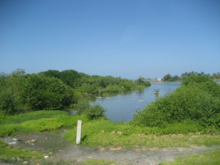 Mangrove near the town of Cienaga, Magdalena, in the Ciénaga Grande de Santa Marta swampy marshes, Colombia.
Mangrove near the town of Cienaga, Magdalena, in the Ciénaga Grande de Santa Marta swampy marshes, Colombia.
Brazil contains approximately 26,000 km2 of mangals, 15% of the world's total of 172,000 km2.
Ecuador and Peru have significant areas of mangroves, mainly in the Gulf of Guayaquil-Tumbes mangroves.
Venezuela's northern Caribbean island, Margarita, possesses mangrove forests in the Parque Nacional la Restinga.
Colombia possesses large mangrove forests on both its Caribbean and Pacific coasts.
Asia
Indomalaya ecozone
Mangroves occur on Asia's south coast, throughout the Indian subcontinent, in all southeast Asian countries, and on islands in the Indian Ocean, Arabian Sea, Bay of Bengal, South China Sea and the Pacific.
The mangal is particularly prevalent in the deltas of large Asian rivers. The Sundarbans is the largest mangrove forest in the world, located in the Ganges river delta in Bangladesh and West Bengal, India.
The Pichavaram Mangrove Forest near Chidambaram, South India, by the Bay of Bengal, is the world's second largest mangrove forest.
Major mangals live on the Andaman and Nicobar Islands and the Gulf of Kutch in Gujarat.[24] Other significant mangals in India include the Bhitarkanika Mangroves and Godavari-Krishna mangroves.
There are mangroves in certain muddy swampy islands of the Maldives.[25]
In Vietnam, mangrove forests grow along the southern coast, including two forests: the Can Gio Mangrove Forest biosphere reserve and the U Minh mangrove forest in the Sea and Coastal Region of Kien Giang, Ca Mau and Bac Lieu province.
The mangrove forests of Kompong Sammaki in Cambodia are of major ecological and cultural importance, as the human population relies heavily on the crabs and fish that live in the roots.
The three most important mangrove forests of Taiwan are: Tamsui River in Taipei, Jhonggang River in Miaoli and the Sihcao Wetlands in Tainan. According to research, there are four existing types of mangrove in Taiwan.[citation needed] Some places have been developed as scenic areas, such as the log raft routes in Sihcao.
Indonesia
In the Indonesian Archipelago, mangroves occur around much of Sumatra, Borneo, Sulawesi and the surrounding islands, while further north, they are found along the coast of the Malay Peninsula. Indonesia has around 9.36 million hectares of mangrove forests, but 48 percent is categorised as 'moderately damaged' and 23 percent as 'badly damaged'.[26]
-
A mangrove of the genus Sonneratia, showing abundant pneumatophores growing on the landward margin of the reef flat on Yap.
Pakistan
Pakistani mangroves are located mainly along the Indus delta (the Indus River Delta-Arabian Sea mangroves ecoregion). Major mangrove forests are found on the coastline of the provinces of Sindh and Balochistan. In Karachi, land reclamation projects have led to the cutting down of mangrove forests for commercial and urban development.
Middle East
Oman, near Muscat, supports large areas of mangroves, in particular at Shinas, Qurm Park and Mahout Island. In Arabic, mangrove trees are known as qurm, thus the mangrove area in Oman is known as Qurm Park. Mangroves are also present extensively in neighboring Yemen.[27]
Iranian mangrove forests occur between 25°11′N to 27°52′N. These forests exist in the north part of the Persian Gulf and Oman Sea, along three maritime provinces in the south of Iran. These provinces respectively from southwest to southeast of Iran, include Bushehr, Hormozgan and Sistan & Balouchestan.
Oceania
Australia and New Guinea
Main article: Australian mangrovesMore than fifty species of Rhizophoraceae grow in Australasia[28] with particularly high biodiversity on the island of New Guinea and northern Australia.[28]
Australia has approximately 11,500 km2 of mangroves, primarily on the northern and eastern coasts of the continent, with occurrences as far south as Millers Landing in Wilsons Promontory, Victoria[29] (38°54′S)[30] and Barker Inlet in Adelaide, South Australia.[31]
New Zealand
New Zealand also has mangrove forests extending to around 38°S (similar to Australia's southernmost mangrove incidence): the furthest geographical extent on the west coast is Raglan Harbour (37°48′S); on the east coast, Ohiwa Harbour (near Opotiki) is the furthest south mangroves are found (38°00′S).[32]
Pacific islands
Twenty-five species of mangrove are found on various Pacific islands, with extensive mangals on some islands. Mangals on Guam, Palau, Kosrae and Yap have been badly affected by development.[33]
Mangroves are not native to Hawaii, but the red mangrove, Rhizophora mangle, and Oriental mangrove, Bruguiera sexangula, have been introduced and are now naturalized.[34] Both species are classified as pests by the University of Hawaii Botany Department.[35]
Exploitation and conservation
Approximately 35% of mangrove area was lost during the last several decades of the twentieth century (in countries for which sufficient data exist), which encompass about half of the area of mangroves.[36] The United Nations Environment Program also estimated shrimp farming causes a quarter of the destruction of mangrove forests.[37] Likewise, the 2010 update of the World Mangrove Atlas (WMA) indicated a fifth of the world's mangrove ecosystems have been lost since 1980.[38]
Grassroots efforts to save mangroves from development are becoming more popular as the benefits of mangroves become more widely known. In the Bahamas, for example, active efforts to save mangroves are occurring on the islands of Bimini and Great Guana Cay. In Trinidad and Tobago as well, efforts are underway to protect a mangrove threatened by the construction of a steelmill and a port.[39] In Thailand, community management has been effective in restoring damaged mangroves.[40]
It has been cited that mangroves can help buffer against Tsunami, cyclones, and other storms. One village in Tamil Nadu was protected from tsunami destruction - the villagers in Naluvedapathy planted 80,244 saplings to get into the Guinness Book of World Records. This created a kilometre-wide belt of trees of various varieties. When the tsunami struck, much of the land around the village was flooded, but the village itself suffered minimal damage.[41][42]
Reforestation
In some areas, mangrove reforestation is also underway. Red mangroves are the most common choice for cultivation, used particularly in marine aquariums in a sump to reduce nitrates and other nutrients in the water. Mangroves also appear in home aquariums, and as ornamental plants, such as in Japan.
In Senegal, Haïdar El Ali has started the Océanium de Dakar project, which (amongst others) focuses on reforesting several areas with mangroves.[43]
The Manzanar Mangrove Initiative is an ongoing experiment in Arkiko, Eritrea, part of the Manzanar Project founded by Dr Gordon H. Sato, establishing new mangrove plantations on the coastal mudflats. Initial plantings failed, but observation of the areas where mangroves did survive by themselves led to the conclusion that nutrients in water flow from inland were important to the health of the mangroves. Trials with the Eritrean Ministry of Fisheries followed, and a planting system was designed to introducing the nitrogen, phosphorus, and iron missing from seawater. The propagules are planted inside a reused galvanized steel can with the bottom knocked out; a small piece of iron and a pierced plastic bag with fertilizer containing nitrogen and phosphorus are buried with the propagule. As at 2007, after six years of planting, there are 700,000 mangroves growing; providing stock feed for sheep and habitat for oysters, crabs, seashells and fish.[44][45]
National studies
In terms of local and national studies of mangrove loss, the case of Belize's mangroves is illustrative in its contrast to the global picture. A recent, satellite-based study[22] - funded by the World Wildlife Fund (WWF) and conducted by the Water Center for the Humid Tropics of Latin America and the Caribbean (CATHALAC) – indicates Belize's mangrove cover declined by a mere 2% over a thirty-year period. The study was borne out of the need to verify the popular conception that mangrove clearing in Belize was rampant.[46] Instead, the assessment showed that between 1980 and 2010, under 4,000 acres (16 km2) of mangroves had been cleared, although clearing of mangroves near Belize's main coastal settlements (e.g. Belize City and San Pedro) was relatively high. The rate of loss of Belize's mangroves - at 0.07% per year between 1980 and 2010 - was much lower than Belize's overall rate of forest clearing (0.6% per year between 1980 and 2010).[47] These findings can also be interpreted to indicate Belize's mangrove regulations (under the nation's [48]) have largely been effective. Nevertheless, the need to protect Belize's mangroves is imperative, as a 2009 study by the World Resources Institute (WRI) indicates the ecosystems contribute US$174–249 million per year to Belize's national economy.[49]
In popular media
- The mangrove is used as a symbol in Annie Dillard's essay Sojourner due to its significance as a self-sustaining biome.
- The manga series One Piece features a forest of giant mangroves that form the Sabaody Archipelago. The mangroves produce a resin that combines with the oxygen exhaled by the trees to create large bubbles. The local population uses the bubbles for everything from transport to hotels.
Notes
- ^ a b Hogarth, Peter J. (1999) The Biology of Mangroves Oxford University Press, Oxford, England, What page? ISBN 0-19-850222-2
- ^ a b Morphological and Physiological Adaptations: Florida mangrove website
- ^ a b c d Mangal (Mangrove). World Vegetation. Mildred E. Mathias Botanical Garden, University of California at Los Angeles
- ^ a b Mazda, Y.; Kobashi, D. and Okada, S. (2005) "Tidal-Scale Hydrodynamics within Mangrove Swamps" Wetlands Ecology and Management 13(6): pp. 647-655
- ^ a b Danielsen, F. et al. (2005) "The Asian tsunami: a protective role for coastal vegetation" Science 310: p. 643.
- ^ a b Massel, S. R.; Furukawa, K.and Brinkman R. M. (1999) "Surface wave propagation in mangrove forests" Fluid Dynamics Research 24(4): pp. 219–249
- ^ Mazda, Yoshihiro et al. (1997) "Drag force due to vegetation in mangrove swamps" Mangroves and Salt Marshes 1: pp. 193–199
- ^ Baird, Andrew (26 December 2006) "False Hopes and Natural Disasters" New York Times editorial
- ^ Dahdouh-Guebas, F. et al. (2005) "How effective were mangroves as a defence against the recent tsunami?" Current Biology 15(12): pp. 443–447
- ^ Encarta Encyclopedia 2005. Article — Seashore, by Heidi Nepf.
- ^ Skov, Martin W. and Hartnoll, Richard G. (March 2002). Paradoxical selective feeding on a low-nutrient diet: why do mangrove crabs eat leaves? Oecologia 131(1): pp. 1–7.
- ^ UN Report on mangrove diversity
- ^ Calfo, Anthony (2006). Mangroves for the Marine Aquarium.
- ^ Ricklefs, R. E., A. Schwarzbach, and S. S. Renner. 2006. Rate of lineage origin explains the diversity anomaly in the World’s mangrove vegetation. American Naturalist 168: 805–810.
- ^ O'Neill.T (February 2007). "Curse of the Black Gold". National Geographic: 88 to 117.
- ^ "Modeling Hurricane Effects on Mangrove Ecosystems" U.S. Geological Survey, USGS FS-095-97, June 1997
- ^ "Coastal Mangrove-Marsh Shrubland" (PDF). Conservation Habitats & Species Assessments. Louisiana Department of Wildlife & Fisheries. December 2005. http://www.wlf.state.la.us/pdfs/experience/Coastal%20Mangrove-Marsh%20Shrubland.pdf.
- ^ Yang, Chenghai; Everitt, James; Fletcher, Reginald; Jensen, Ryan;Mausel, Paul (2008-03-15). "Mapping Black Mangrove Along the South Texas Gulf Coast Using AISA+ Hyperspectral Imagery". Biennial Workshop on Aerial Photography, Videography, and High Resolution Digital Imagery for Resource Assessment Proceedings (American Society for Photogrammetry and Remote Sensing). http://www.ars.usda.gov/research/publications/publications.htm?seq_no_115=213366.
- ^ Vreugdenhil, D., Meerman, J., Meyrat, A., Gómez, L.D., and D.J. Graham. 2002. "Map of the Ecosystems of Central America: Final Report." World Bank, Washington, DC. 56 pp. http://biological-diversity.info/Downloads/Ecosystem%20Mapping.zip
- ^ Murray, M.R., Zisman, S.A., Furley, P.A., Munro, D.M., Gibson, J., Ratter, J., Bridgewater, S., Mity, C.D., and C.J. Place. 2003. "The Mangroves of Belize: Part 1. Distribution, Composition and Classification." Forest Ecology and Management 174: 265–279
- ^ Zisman, S.A. 1998. "Sustainability or Status Quo: Elite Influence and the Political Ecology of Mangrove Exploitation in Belize." Doctoral dissertation, Department of Geography, University of Edinburgh. Edinburgh, Scotland.
- ^ a b Cherrington, E.A., Hernandez, B.E., Trejos, N.A., Smith, O.A., Anderson, E.R., Flores, A.I., and B.C. Garcia. 2010. "Identification of Threatened and Resilient Mangroves in the Belize Barrier Reef System." Technical report to the World Wildlife Fund. Water Center for the Humid Tropics of Latin America and the Caribbean (CATHALAC) / Regional Visualization & Monitoring System (SERVIR). 28 pp. http://maps.cathalac.org/Downloads/data/bz/bz_mangroves_1980-2010_highres.pdf
- ^ http://www.nasa.gov/home/hqnews/2010/oct/HQ_10-241_SERVIR_Himalaya.html
- ^ Mangroves of India - URL retrieved November 26, 2006
- ^ Xavier Romero-Frias, The Maldive Islanders, A Study of the Popular Culture of an Ancient Ocean Kingdom. Barcelona 1999, ISBN 84-7254-801-5
- ^ http://www.thejakartapost.com/news/2011/08/07/71-indonesian-mangrove-forests-damaged-minister.html
- ^ Rouphael, Tony ;Turak, Emre and Brodie, Jon (1992) "Chapter 3: Seagrasses and Mangroves of Yemen's Red Sea" In DouAbal, A. et al. (editors) (1992) Protection of Marine Ecosystems of the Red Sea Coast of Yemen Global Environment Facility, United Nations Development Programme, New York, pp. 41-49
- ^ a b Food and Agriculture Organization of the United Nations (FAO) (2007) The world's mangroves, 1980-2005: a thematic study in the framework of the Global Forest Resources Assessment 2005 (FAO forestry paper #153(FAO) Rome,page 37, ISBN 978-92-5-105856-5
- ^ "Millers Landing". Victorian Resources Online:West Gippsland. Department of Primary Industries.. http://www.dpi.vic.gov.au/dpi/vro/wgregn.nsf/pages/wg_lf_sig_shallow_corner3. Retrieved 2009-03-30.
- ^ "Millers Landing". Geoscience Australia Place Names Search. Australian Government. http://www.ga.gov.au/bin/gazd01?rec=248996. Retrieved 2009-03-30.
- ^ Zann, Leon P. (1996) [1995]. "Mangrove ecosystems in Australia: structure, function and status". State of the Marine Environment Report for Australia. Australian Government, Dept of Environment and Heritage. ISBN 0-642-17399-0. ISBN. http://www.deh.gov.au/coasts/publications/somer/annex1/mangrove.html. Retrieved 2006-11-25.
- ^ Mangroves and Seagrasses - Treasures of the Sea
- ^ Hawaii and the Pacific Islands
- ^ Allen, James A. and Krauss, Ken W. (2006) "Influence of Propagule Flotation Longevity and Light Availability on Establishment of Introduced Mangrove Species in Hawai'i". Pacific Science 60:3, July 2006. Abstract at [1] - URL retrieved November 28, 2006.
- ^ Hawaiian Alien Plant Studies - URL retrieved November 28, 2006.
- ^ Millennium Ecosystem Assessment (2005) Ecosystems and Human Well-being: Synthesis (p.2) Island Press, Washington, DC. World Resources Institute ISBN 1-59726-040-1
- ^ Botkin, D. and E. Keller (2003) Environmental Science: Earth as a living planet (p.2) John Wiley & Sons. ISBN 0-471-38914-5
- ^ The Nature Conservancy (TNC). 2010a. ""World Atlas of Mangroves" Highlights the Importance of and Threats to Mangroves: Mangroves among World's Most Valuable Ecosystems." Press release. Arlington, Virginia. http://www.nature.org/pressroom/press/press4573.html
- ^ http://www.thepetitionsite.com/petition/957999809
- ^ http://ecotippingpoints.org/our-stories/indepth/thailand-mangrove-restoration-community-management.html
- ^ Tree News, Spring/Summer 2005,Publisher Felix Press
- ^ Mangrove India website
- ^ Oceanium de Dakar
- ^ Warne, Kennedy; Tim Laman, photographer (2007-02). "Mangroves: Forests of the Tide". National Geographic. National Geographic Society. http://ngm.nationalgeographic.com/2007/02/mangroves/warne-text/5. Retrieved 2010-08-08.
- ^ Sato, Gordon; Abraham Fisseha, Simon Gebrekiros, Hassan Abdul Karim, Samuel Negassi, Martin Fischer, Emanuel Yemane, Johannes Teclemariam, and Robert Riley (2005-09). "A Novel Approach to Growing Mangroves on the Coastal Mud Flats of Eritrea with the Potential for Relieving Regional Poverty and Hunger". Wetlands (The Society of Wetland Scientists) 25 (3): 776–779. doi:10.1672/0277-5212(2005)025[0776:ANATGM]2.0.CO;2. http://springerlink.com/content/p251664gp74v5681/. Retrieved 2010-08-08.
- ^ http://ambergriscaye.com/pages/town/art/Pelican_Review.pdf
- ^ Cherrington, E.A., Ek, E., Cho, P., Howell, B.F., Hernandez, B.E., Anderson, E.R., Flores, A.I., Garcia, B.C., Sempris, E., and D.E. Irwin. 2010. "Forest Cover and Deforestation in Belize: 1980-2010." Water Center for the Humid Tropics of Latin America and the Caribbean. Panama City, Panama. 42 pp. http://www.servir.net/servir_bz_forest_cover_1980-2010.pdf
- ^ Government of Belize (GOB). 2003. "Forests Act Subsidiary Laws." Chapter 213 in: Substantive Laws of Belize. Revised Edition 2003. Government Printer: Belmopan, Belize. 137 pp. http://www.belizelaw.org/lawadmin/PDF%20files/cap213s.pdf
- ^ Cooper, E., Burke, L., and N. Bood. 2009. "Coastal Capital: Belize. The Contribution of Belize's Coral Reefs and Mangroves." WRI Working Paper. World Resources Institute, Washington, DC. 53 pp. http://pdf.wri.org/working_papers/coastal_capital_belize_wp.pdf
See also
- Changes in global mangrove distributions
- Ecological values of mangrove
- List of mangrove ecoregions
- Mudflat
- Salt marsh
References
- Saenger, Peter (2002). Mangrove Ecology, Silviculture, and Conservation. Kluwer Academic Publishers, Dordrecht. ISBN 1-4020-0686-1.
- Hogarth, Peter J. (1999). The Biology of Mangroves. Oxford University Press, Oxford. ISBN 0-19-850222-2.
- Thanikaimoni, Ganapathi (1986). Mangrove Palynology UNDP/UNESCO and the French Institute of Pondicherry, ISSN 0073-8336 (E).
- Tomlinson, Philip B. (1986). The Botany of Mangroves. Cambridge University Press, Cambridge, ISBN 0-521-25567-8.
- Teas, H. J. (1983). Biology and Ecology of Mangroves. W. Junk Publishers, The Hague. ISBN 90-6193-948-8.
- Plaziat, J.C., et al. (2001). "History and biogeography of the mangrove ecosystem, based on a critical reassessment of the paleontological record". Wetlands Ecology and Management 9 (3): pp. 161–179.
- Sato, Gordon; Riley, Robert; et al. Growing Mangroves With The Potential For Relieving Regional Poverty And Hunger WETLANDS, Vol. 25, No. 3 – September 2005
- Jayatissa, L. P., Dahdouh-Guebas, F. & Koedam, N. (2002). "A review of the floral composition and distribution of mangroves in Sri Lanka". Botanical Journal of the Linnean Society 138: 29–43.
- Warne, K. (February 2007). "Forests of the Tide". National Geographic pp. 132–151
- Aaron M. Ellison (2000) "Mangrove Restoration: Do We Know Enough?" Restoration Ecology 8 (3), 219–229 doi: 10.1046/j.1526-100x.2000.80033.x
- Agrawala, Shardul; Hagestad; Marca; Koshy, Kayathu; Ota, Tomoko; Prasad, Biman; Risbey, James; Smith, Joel; Van Aalst, Maarten. 2003. Development and Climate Change in Fiji: Focus on Coastal Mangroves. Organisation of Economic Co-operation and Development, Paris, Cedex 16, France.
- Barbier, E.B., Sathirathai, S., 2001. Valuing Mangrove Conservation in Southern Thailand. Contemproary Economic Policy. 19 (2) 109–122.
- Bosire, J.O., Dahdouh-Guebas, F., Jayatissa, L.P., Koedam, N., Lo Seen, D., Nitto, Di D. 2005. How Effective were Mangroves as a Defense Against the Recent Tsunami? Current Biology Vol. 15 R443-R447.
- Bowen, Jennifer L., Valiela, Ivan, York, Joanna K. 2001. Mangrove Forests: One of the World's Threatened Major Tropical Environments. Bio Science 51:10, 807–815.
- Jin-Eong, Ong. 2004. The Ecology of Mangrove Conservation and Management. Hydrobiologia. 295:1-3, 343–351.
- Glenn, C. R. 2006. "Earth's Endangered Creatures" (Online). Accessed 4/28/2008 at http://earthsendangered.com.
- Lewis, Roy R. III. 2004. Ecological Engineering for Successful Management and Restoration of Mangrove Forest. Ecological Engineering. 24:4, 403–418.
- Lucien-Brun H. 1997. Evolution of world shrimp production: Fisheries and aquaculture. World Aquaculture. 28:21–33.
- Twilley, R. R., V.H. Rivera-Monroy, E. Medina, A. Nyman, J. Foret, T. Mallach, and L. Botero. 2000. Patterns of forest development in mangroves along the San Juan River estuary, Venezuela. Forest Ecology and Management.
- Murray, M.R., Zisman, S.A., Furley, P.A., Munro, D.M., Gibson, J., Ratter, J., Bridgewater, S., Mity, C.D., and C.J. Place. 2003. "The Mangroves of Belize: Part 1. Distribution, Composition and Classification." Forest Ecology and Management 174: 265–279
- Cherrington, E.A., Hernandez, B.E., Trejos, N.A., Smith, O.A., Anderson, E.R., Flores, A.I., and B.C. Garcia. 2010. "Identification of Threatened and Resilient Mangroves in the Belize Barrier Reef System." Technical report to the World Wildlife Fund. Water Center for the Humid Tropics of Latin America and the Caribbean (CATHALAC) / Regional Visualization & Monitoring System (SERVIR). 28 pp. http://maps.cathalac.org/Downloads/data/bz/bz_mangroves_1980-2010_highres.pdf
- Vreugdenhil, D., Meerman, J., Meyrat, A., Gómez, L.D., and D.J. Graham. 2002. "Map of the Ecosystems of Central America: Final Report." World Bank, Washington, DC. 56 pp.
Further reading
- Spalding, Mark; Kainuma, Mami and Collins, Lorna (2010) World Atlas of Mangroves Earthscan, London, ISBN 978-1-84407-657-4; 60 maps showing world-wide mangrove distribution
External links
- Mangroves- At the Smithsonian Ocean Portal
- Rhizophoraceae at the Open Directory Project
- Mangrove forests at the Open Directory Project
- In May 2011, the VOA Special English service of the Voice of America broadcast a 15-minute program on mangrove forests. A transcript and MP3 of the program, intended for English learners, can be found at Mangrove Forests Could Be a Big Player in Carbon Trading
Biomes and Ecozones Terrestrial
biomesPolar/montaneTemperate(Sub)tropicalDryWetAquatic
biomesPond · Littoral · Intertidal zone · Mangrove forest · Kelp forest · Coral reef · Neritic zone · Continental shelf · Pelagic zone · Benthic zone · Hydrothermal vents · Cold seepsOther biomes Ecozones Sources of condensed tannins Areca catechu seed (arecatannins) | Broad bean (Vicia faba) | Grape (Vitis vinifera) | Quebracho wood | Mimosa bark (Acacia mollissima) | Myrtan or black marlock (Eucalyptus redunca)Sources of hydrolysable tannins Chestnut wood | Dhawa (Anogeissus latifolia) | Myrobalan fruit (Terminalia chebula) | Oak wood, bark or acorn cup (Valonea Quercus macrolepis) | Sumac (Tanner's sumach leaves - Rhus coriaria or Chinese gall on Rhus chinensis) | Tara pod (Caesalpinia spinosa)Other sources Alder (Alnus sp) | Avaram (Senna auriculata) | Babul (Acacia nilotica) | Birch (Betula sp) | Larch (Larix sp) | Hemlock (Tsuga sp) | mangrove | Pine (Pinus sp) | Spruce (Picea sp) | Urunday (Myracrodruon urundeuva) | Willow (Salix caprea)Cutch (Acacia catechu)Whole plantProsopis sp. bark and wood (eg Prosopis humilis or Algarrobilla) | Tanoak (Lithocarpus densiflorus) | Tizra heartwood and root (Rhus pentaphylla)Misc Categories:- Mangroves
- Aquatic biomes
- Terrestrial biomes
- Aquatic ecology
- Mangrove ecoregions
Wikimedia Foundation. 2010.


